BTSX 2017/2018 Annual Update
 April of 2017 marked the end of our first decade of early retirement. It was an interesting exercise to reflect on that time. We left work just before the Financial Crisis and then watched the stock markets lose 40%+ of their value. I may be stating the obvious but the worst time to retire is at the beginning of a market decline. It certainly was a test of our investment strategy.
April of 2017 marked the end of our first decade of early retirement. It was an interesting exercise to reflect on that time. We left work just before the Financial Crisis and then watched the stock markets lose 40%+ of their value. I may be stating the obvious but the worst time to retire is at the beginning of a market decline. It certainly was a test of our investment strategy.
Ironically, I spent many years working as an electronics test engineer devising ways to push electronic assemblies to extremes to identify failure mechanisms. I was well aware of the benefits of such testing. The end result produced high confidence that the assembly would work reliably even under extreme conditions. Fortunately, the stress test of the Financial Crisis on the Beating the TSX (BTSX) strategy had a positive outcome in the long term. By sticking with dividend-paying stocks and staying invested in the market, it paid off. The markets recovered all their losses and have reached new highs. The dividends eventually started to grow with many of the stock’s dividends growing much faster than inflation.
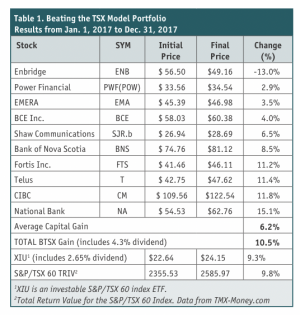
If you followed my advice in last year’s summary, you have kept track of the return of your portfolio and are able to compare your return to the return of the BTSX. Hopefully you have equalled or exceeded the BTSX return and have not spent too much time in the process. There will be few investors that both beat the long-term returns of the BTSX strategy and only spent 8 hours per year of effort.
For new CMS readers, please note that I use David Stanley’s BTSX process to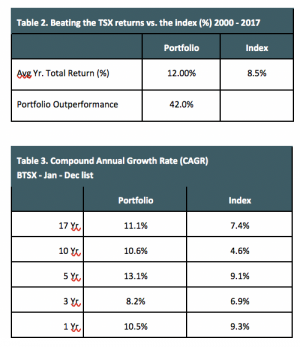 pick the stocks each December 31st for the following year, with a few modifications. If you are interested in the modifications you can reference my February 2016 article which can be found on the CMS website.
pick the stocks each December 31st for the following year, with a few modifications. If you are interested in the modifications you can reference my February 2016 article which can be found on the CMS website.
January - December 2017 Results
As you can see from Table 1, the return for the BTSX portfolio was 10.5%. This was 1.2% more than the iShares S&P/TSX index ETF (XIU) of 9.3%. I have also included the S&P/TSX 60 Total Return Index Value (TRIV) for comparison.
2017 was again one of the years that BTSX lived up to its name. It has occurred to me on many occasions that the name BTSX sure puts a lot of pressure on a very specific goal. Maybe the strategy should be renamed “A Fairly Good Return Without Much Effort”. This would give me a lot more leeway in-terms of performance. I had better stop there as I am starting to sound much like a professional fund manager trying to negotiate a lower performance target.
I would like to point out that the 9.3% XIU return is great considering an investor would only have to purchase a single ETF rather than the 10 separate stocks in the BTSX. As a simple alternative to the BTSX process, I always suggest using the XIU ETF as a starting point for new investors or experienced investors who don’t have time to invest in individual stocks. I still own the XIU shares that I purchased when starting my portfolio decades ago. In years when XIU outperforms the BTSX, I am always happy to still own them.
As you review the results you will notice that Enbridge (ENB) did not have a good year even though they increased their dividend by 14.5% in 2017 and announced a 10% dividend increase that will take effect in early 2018. I find situations like this quite exciting as you can buy ENB for 13% less than on January 1st, 2017 but it is paying a 24.5% higher dividend. It is worth a closer look.
Table 2 shows the average results over the last 17 years. The BTSX portfolio that I have been using is outperforming the index by over 42%. Earning an average of 12% will allow many investors to easily meet their financial goals.
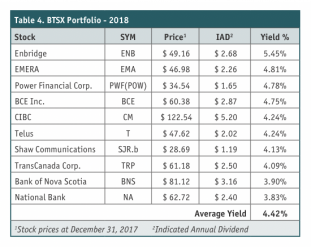
For those of you that use other financial strategies or have turned your investments over to a financial advisor, it is important that you compare your long term returns to these numbers as one potential benchmark. It is the longer-term results that all investors need to focus on. The returns of any one year are much less important.
In Table 3 the Compound Annual Growth Rate (CAGR) is shown, rather than the simple average numbers I usually work with. The CAGR number will allow a comparison to mutual fund returns or any other investment returns that indicate their CAGR number. As you can see, the BTSX portfolio currently is outperforming the index in all timeframes.
2018 BTSX Portfolio
Table 4 lists the stock picks for 2018. These stocks are purchased January 1st and held until the end of the year, unless they cut their dividend.
You can use this list as you choose. You may wish to purchase all the stocks or perhaps use this list as a suggestion of high yielding stocks from the S&P/TSX 60 to review further.
The 4.4% dividend yield of this year’s list is another one of the exciting things about this strategy. If you can live off 4% or less of your portfolio, as is often recommended by financial experts, then you can fund your retirement income from the dividends received without having to sell any capital, making portfolio income management quite simple.
DOGs Of The Dow Portfolio
As readers of my book know, I also invest in Dogs of the Dow, so I have decided to provide this list of stocks as well. This provides a U.S. portfolio of high dividend-paying blue chip stocks. As you can see from Table 5, for 2017 there was a return of 22.9 %. It is hard to be disappointed with such a high return, but as you can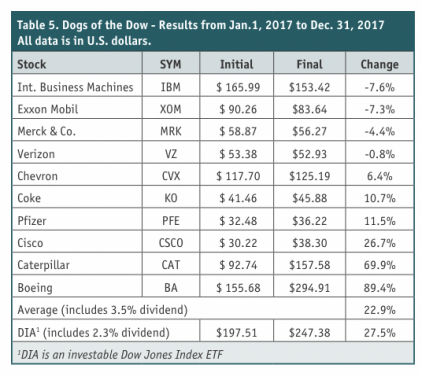
see we underperformed compared to the index which increased 27.5%. It was quite a good year for the U.S. markets!
In the list, Boeing (BA) and Caterpillar (CAT) contributed significantly to the overall return. When looking closer at all 30 stocks in the Dow Jones, I can see that there are a handful of stocks that did exceptionally well and helped drive the average up. You would have a fantastic return if you knew what those highflying stocks would be in advance. Since this is not possible, it is best to buy a larger group of stocks and focus on the overall return of the group. This methodology will more steadily move you towards your investment goals.
This return is in U.S. dollars and thus does not factor in any changes in the portfolio due to the varying exchange rate. Table 6 shows the average results from the last 13 years with an outperformance of 9%. This result is lower than the BTSX result, but is still in our favour.
Table 7 lists the stock picks for 2018. General Electric (GE) should be in the 10th position, if we were going with the true Dogs of the Dow list as I usually do. Due to a recent 50% cut of the GE dividend I have chosen to skip GE and replace it with the 11th stock, which is Johnson & Johnson (JNJ). As readers of my articles will know, I have found stocks that cut their dividends tend to have poor performance for many years after the event. This is not always the case, but there is too much risk for my liking to keep the dividend cutter in my portfolio.
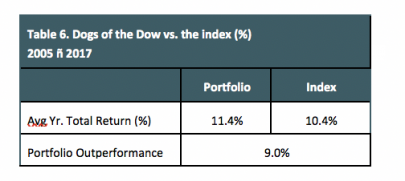
I will be purchasing all of the new stocks in the 2018 lists for BTSX and Dogs of the Dow, and hoping for the best, as usual. Due to the dividend increases, one of the benefits of owning these dividend stocks is that the total income from the portfolio is growing at or above inflation each year. The total income gets an extra boost in January when the lower yielding stocks that move out of the top 10 are sold and then replaced with higher yielding stocks.
Fortunately with this system, all that is left to do for the next 12 months is to watch for any dividend changes. Hopefully there will be many more increases than decreases.
If you have any questions or would like more information, please feel free to contact me.
Ross Grant is the e-book Author of Destination: Early Financial Independence, available on Amazon and Kobo. Free e-reader software is available for PCs, MACs, etc. to view the book. Please email Ross if you need the links. You can reach him at RossGrantEFI@gmail.com

